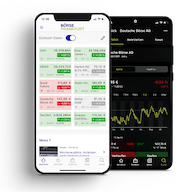Glossary
- DAX
- DAX future
- Day-Trading
- Dealer
- Delta (warrant)
- Derivatives
- Derivatives exchange
- Derivatives market
- Designated Sponsor
- Dilution of ownership
- Direct bank
- Direct listing
- Direct offering
- Directors' Dealings
- Discount broker
- Discount certificates
- Discount rate
- Distribution
- DivDAX
- Diversification
- Dividend
- Dividend guarantee
- Dividend stripping
- Dividend yield
- Double listing
- Downward movement
- Dual Listing (DL)
DAX
The German DAX® benchmark index has been calculated by Deutsche Börse AG since July 1, 1988. It represents around 80 percent of the market capitalization of listed stock corporations in Germany and around 90 percent of stock market turnover in German shares.
DAX stocks are listed in the two segments of the Regulated Market, Prime and General Standard. The criteria for weighting shares in DAX is the market capitalization of the free float. DAX is calculated and updated every second as a price and performance index from Xetra prices. Deutsche Börse decides on changes to the index composition twice a year at ordinary adjustment dates in March and September.
Since December 2020 until September 2021, the composition rules have been comprehensively revised. In addition to the expansion to 40 companies, this again includes qualitative criteria such as profitability, submission of financial reports, audit committee on the supervisory board. An overview of the index reform is available at boerse-frankfurt.de/en/dax-40.
Price data for the DAX and its constituent stocks can be found at boerse-frankfurt.de/DAX,
Details on index adjustments can be found on boerse-frankfurt.de in the
Know-how
section.




